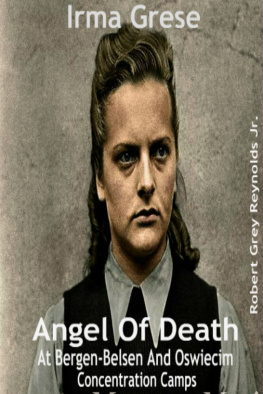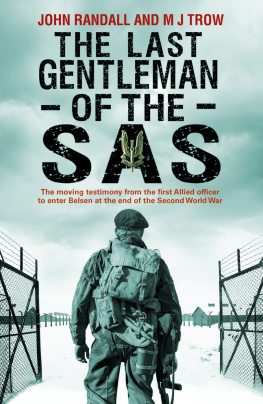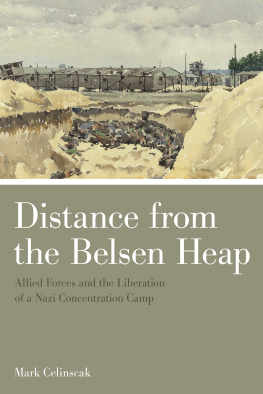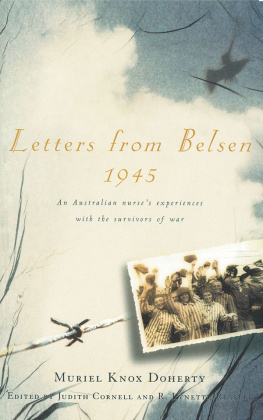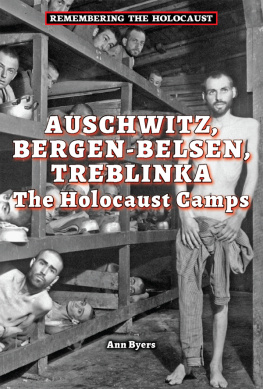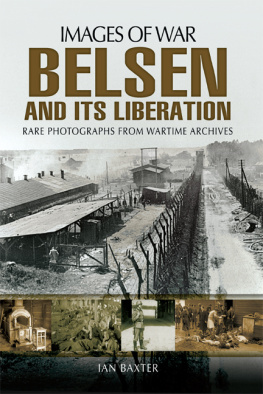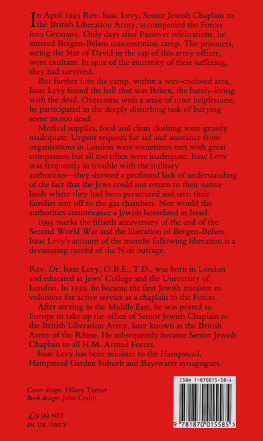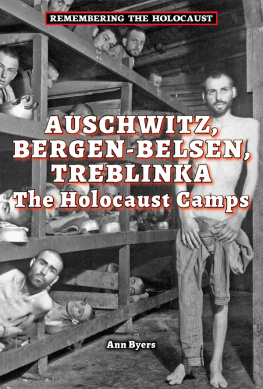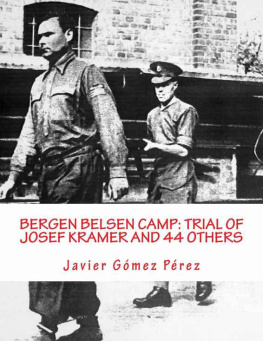ALL THE HORRORS OF WAR
ALL THE HORRORS OF WAR
A JEWISH GIRL, A BRITISH DOCTOR, AND THE LIBERATION OF BERGEN-BELSEN
BERNICE LERNER

2020 Johns Hopkins University Press
All rights reserved. Published 2020
Printed in the United States of America on acid-free paper
2 4 6 8 9 7 5 3 1
Johns Hopkins University Press
2715 North Charles Street
Baltimore, Maryland 21218-4363
www.press.jhu.edu
Library of Congress Cataloging-in-Publication Data
Names: Lerner, Bernice, author.
Title: All the horrors of war : a Jewish girl, a British doctor, and the liberation of Bergen-Belsen / Bernice Lerner.
Description: Baltimore : Johns Hopkins University Press, [2020] | Includes bibliographical references and index.
Identifiers: LCCN 2019027983 | ISBN 9781421437705 (hardcover) | ISBN 9781421437712 (ebook)
Subjects: LCSH: Genuth, RachelBiography. | Holocaust survivorsBiography. | Hughes, Glyn (Hugh Llewelyn Glyn), 18921973Relations with Holocaust survivors. | Bergen-Belsen (Concentration camp)Biography. | Ex-concentration camp inmatesBiography.
Classification: LCC D805.5.B47 L47 2020 | DDC 940.53/18092 [B]dc23
LC record available at https://lccn.loc.gov/2019027983
A catalog record for this book is available from the British Library.
The map on pages is by Kelly Sandefer, Beehive Mapping.
Cover and interior design by Amanda Weiss
Special discounts are available for bulk purchases of this book. For more information, please contact Special Sales at .
Johns Hopkins University Press uses environmentally friendly book materials, including recycled text paper that is composed of at least 30 percent post-consumer waste, whenever possible.
FOR
Isla, Ruby, Sidney, and Caleb
I thought that most of us who survived would never be human again. We were treated worse than animals, we were so dehumanized, and with so little to hope for, I just could not imagine ever getting married and having a family.
RACHEL GENUTH, liberated in Bergen-Belsen on April 15, 1945
Belsen was unique in its vile treatment of human beings. Nothing like it had happened before in the history of mankind. The victims of this infamous behavior had been reduced to a condition of subhuman existence, and there we were, a mere handful of war-weary men trying to save those who could still be saved and to allay the sea of suffering and the depths of agony.
BRIGADIER HUGH LLEWELYN GLYN HUGHES, in Sam Bloch, ed., Holocaust and Rebirth 19451965
ALL THE HORRORS OF WAR
PROLOGUE
The beginning of the end of Rachel Genuths childhood may be traced to an afternoon in early September 1940. It was during the harvest, the time of year when Rachel helped her father, Moshe, a produce trader, lift crates of fruit to be sold to retail vendors. All summer long, the tomboyish ten-year-old accompanied Moshe on trips to orchards; she mounted wagons full of watermelons, climbed trees, and with her pocketknife cut swirled apple peels that when tossed behind her formed the first initial of the man she would marryusually an S. (She hoped it would be Sruli, her bookish neighbor who once, seeing her try to sweep a floor, had taught her the correct way to do the job.)
On what began as an ordinary day, Rachel and her friend Raize walked two miles to an orchard on the outskirts of Sighet to bring Moshe his lunch. As a dozen laborers worked the grove and Rachel and Raize wove through rows of trees, everyone suddenly heard a military band approaching from the direction of the former Czechoslovakia (now under Hungarian rule). The nearby border had been crossed. At the sound of gunshots, Moshe told Rachel and Raize to run and hide in the attic of the estates villa. They could come back down when the soldiers passed.
The villas stairwell was narrow, and its attic dingy but not darklight shone in through two small windows. Surveying the space, the girls spotted a dull copper cylinder, an object unlike any they had ever seen. They took a closer look but dared not touch it.
As the Hungarian troops marched toward the orchard, the sounds of brass wind instruments and gunfire grew louder; after the band and soldiers passed, the noise tapered. Rachel ran down to tell her father about the unusual object. Hugging her close, shuddering at the unthinkable,
Not everyone felt as the Romanian landowner did. Walking home, Rachel and Moshe saw people lining the streets, welcomingwith flowers and cheers and Hungarian flagsuniformed soldiers led by officers. When they relayed the news to Rachels mother, Blima, she also rejoiced. Like others of her generation, she had been educated in Hungarian schools; she spoke the language, knew the history, and could recite Magyar (ethnic Hungarian) poems. In this land of changing borders and nationalities, she would now be able to help her children with their homework.
Little did Blima know that her childrens schooling would soon be the least of her concerns.
A few weeks later, while Rachel slept at her grandmother Chayas, a blackbird pecked insistently on the bedroom window. Chaya rose to listen. The bird, she said, was bringing good news: Rachels aunt Malcsi and her family were on their way. Sure enough, before officials closed the border between Romania and Hungary (on October 2, the Hungarian parliament officially incorporated northern Transylvania into its land), Rachels aunt Malcsi, her husband, Mano, and their two childreneight-year-old Baibe, who had won a Shirley Temple look-alike contest, and six-year-old Heime, her clever brotherleft Brasov, Romanias second-largest city, for Sighet. Perhaps they feared the murderous Iron GuardRachel overheard her parents talking about Greenshirts killing Jews. In any event, no border would separate the family.
It was a happy day when aunt Malcsi and her family appeared. Rachel remembered their earlier visits, when they showered her and her siblings with expensive toys (which Blima promptly sold). Aunt Malcsi and Uncle Mano had also sent packages of chocolate, fish oil, and vitaminsitems manufactured in their factory. After Rachels older sister, Elisabeth, spent the summer with them in 1939, she could not stop talking about their elegant apartment with indoor plumbing; their maid, who cleaned, washed, and ironed; and the shopping excursions they took her on. Rachel thought her sister had been terribly spoiled. And she hoped that she too might one day visit Brasov.
But this was not to be. After Hitlers edict, Aunt Malcsi and Uncle Mano sold what they could and left their comfortable cosmopolitan life. They rented a large apartment in Sighet and unpacked what they brought with them, including never-before-seen gadgets that made life easier. Rachels mother had only a wooden bowl and chopper, whereas Malsci had a meat grinder. Blima made stew; sophisticated Malcsi made hamburgers.
Others of Rachels relatives were also well off. Her uncle Nachman, who in his youth had tried to make his way in Palestine, had returned to Sighet and married a woman whose dowry enabled him to open a butcher shop and goose-down business. In addition to his sizable home and two rental apartments, he built a synagogue for his local community. Its garden contained plants with enormous leaves; Rachel showed his three little girls how to use these as sunshades.
***
In June 1941, less than a year after the Hungarian takeover, the Germans invaded Soviet territory. In the ensuing chaos anti-Semitic leaders, motivated by the recent unwelcome influx of Jews from Galicia and Bukovina (regions on the northern slopes of the Carpathian Mountains) and Poland, decided to deport all foreigners. The National Central Alien Control Office would resettle those Jews who could not prove continual Hungarian citizenshipfor themselves and their ancestorsgoing back ninety years. On July 8, 1941, Dr. Gabor Itai, lieutenant governor of the District of Mramaros, in which Sighet was located, promised Jews with unhinged status a new life in Galicia.
Next page

